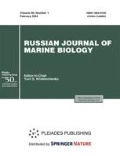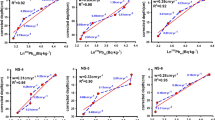Abstract
The seasonal dynamics of biogenic sedimentation in Sevastopol Bay, Black Sea, was studied using thorium-234 (234Th) as a natural radiotracer. The percentage content of biogenic particulate matter in bottom sediments was determined based on the 40K radionuclide according to the previously developed method. Two major maxima of the rate of bottom sedimentation have been recorded: in April–June and in the second half of the summer. In the former case, the peak can apparently be attributed to a more intensive flux of terrigenous particulate matter in the spring; in the latter case, it can apparently be attributed to high values of phytoplankton primary production in the late summer. The results obtained by applying this method provide a more accurate estimate of the mean annual biosedimentation rate, which is required to calculate deposition fluxes of biogenic matter and pollutants to bottom sediments of coastal waters.


Similar content being viewed by others
REFERENCES
Vinberg, G.G. and Kaler, V.L., A comparative study of primary plankton production by the radiocarbon and oxygen methods, Dokl. Akad. Nauk SSSR, 1960, vol. 130, no. 2, pp. 446–449.
Gavshin, V.M., Lapukhov, S.V., and Saraev, S.V., Geokhimiya litogeneza v usloviyakh serovodorodnogo zarazheniya (Chernoye more) (Geochemistry of Lithogenesis under Conditions of Hydrogen Sulfide Contamination (Black Sea)), Novosibirsk: Nauka, 1988.
Gulin, S.B., Radioisotope-based geochronological reconstruction of pollution and eutrophication of the Black Sea, in Radioekologicheskii otklik Chernogo morya na chernobyl’skuyu avariyu (The Radioecological Response of the Black Sea to the Chernobyl Accident), Sevastopol: EKOSI-Gidrofizika, 2008, pp. 519–547.
Gulin, S.B., Sidorov, I.G., and Gulina, L.V., Biogenic sedimentation in the Black Sea: Radiotracer-derived study, Morsk. Ekol. Zh., 2013, vol. 12, no. 2, pp. 19–25.
Ignatieva, O.G., Status of the Sevastopol Bay’s carbonate system components by the data of expeditions in 2006–2007, Morsk. Ekol. Zh., 2009, vol. 8, no. 2, pp. 37–48.
Lopukhina, O.A., Bryantseva, Yu.V., and Kemp, R.B., Seasonal dynamics of phytoplankton in Sevastopol Bay, in Akvatoriya i berega Sevastopolya: ekosistemnye protsessy i uslugi obshchestvu (The Waters and Coast of Sevastopol: Ecosystem Processes and Services to the Society), Sevastopol: Akvavita, 1999, pp. 131–141.
Polikarpov, G.G. and Egorov, V.N., Morskaya dinamicheskaya radiokhemoekologiya (Marine Dynamic Radiochemoecology), Moscow: Energoatomizdat, 1986.
Polikarpov, G.G., Zesenko, A.Ya., Egorov, V.N., and Nazarov, A.B., Application of radioisotope-based methods in the study of production processes and dynamics of organic matter in the ocean, Morsk. Gidrofiz. Issled., 1976, vol. 74, no. 3, pp. 116–124.
Aller, R.C. and DeMaster, D.J., Estimates of particle flux and reworking at the deep-sea floor using 234Th/238U disequilibrium, Earth Planet. Sci. Lett., 1984, vol. 67, pp. 308–318.
Anderson, R.F., Schiff, S.L., and Hesslein, R.H., Determining sediment accumulation and mixing rates using 210Pb, 137Cs, and other tracers: problems due to postdepositional mobility and coring artifacts, Can. J. Fish. Aquat. Sci., 1987, vol. 44, suppl. 1, pp. S231–S250.
Buesseler, K.O., Do upper-ocean sediment traps provide an accurate record of particle flux?, Nature, 1991, no. 353, pp. 420–423.
Buesseler, K.O., Bacon, M.P., Cochran, J.K., and Livingston, H.D., Carbon and nitrogen export during the JGOFS North Atlantic Bloom Experiment estimated from 234Th: 238U disequilibria, Deep-Sea Res., 1992, vol. 39, nos. 7–8, pp. 1115–1137.
Cochran, K.J., Buesseler, K.O., Bacon, M.P., and Livingston, H.D., Thorium isotopes as indicators of particle dynamics in the upper ocean: results from the JGOFS North Atlantic Bloom Experiment, Deep-Sea Res., 1993, vol. 40, no. 8, pp. 1569–1595.
Gerino, M., Aller, R.C., Lee, C., et al., Comparison of different tracers and methods used to quantify bioturbation during a spring bloom: 234-thorium, luminophores and chlorophyll a, Estuarine, Coastal Shelf Sci., 1998, vol. 46, no. 4, pp. 531–547.
Gulin, S.B., Seasonal changes of 234Th scavenging in surface water across the western Black Sea: an implication of the cyclonic circulation patterns, J. Environ. Radioact., 2000, vol. 51, no. 3, pp. 335–347.
Gulin, S.B., 234Th-based measurements of particle flux in surface water of the Bransfield Strait, western Antarctica, J. Radioanal. Nucl. Chem., 2014, vol. 299, no. 1, pp. 819–825.
Gulin, S.B., Aarkrog, A., Polikarpov, G.G., et al., Chronological study of 137Cs input to the Black Sea deep and shelf sediments, Radioprotection, 1997, vol. 32, no. C2, pp. 257–262.
Gulin, S.B., Gulina, L.V., Sidorov, I.G., et al., 40K in the Black Sea: a proxy to estimate biogenic sedimentation, J. Environ. Radioact., 2014, vol. 134, pp. 21–26.
Gulin, S.B., Polikarpov, G.G., Egorov, V.N., et al., Radioactive contamination of the north-western Black Sea sediments, Estuarine, Coastal Shelf Sci., 2001, vol. 54, no. 3, pp. 541–549.
Nittrouer, C.A., DeMaster, D.J., McKee, B.A., et al., The effect of sediment mixing on Pb-210 accumulation rates for the Washington continental shelf, Mar. Geol., 1984, vol. 54, pp. 201–221.
Polikarpov, G.G., Gulin, S.B., Krivenko, O.V., et al., Study of suspended matter and nutrients sedimentation with thorium-234 as radiotracer in the western Black Sea (during various seasons in 1992), Dokl. Nats. Akad. Nauk Ukr., 1994, no. 2, pp. 145–149.
Rutgers van der Loeff, M., Sarin, M., Baskaran, M., et al., A review of present techniques and methodological advances in analyzing 234Th in aquatic systems, Mar. Chem., 2006, vol. 100, pp. 190–212.
Santschi, P.H., Guo, L., Asbill, S., et al., Accumulation rates and sources of sediments and organic carbon on the Palos Verdes shelf based on radioisotopic tracers (137Cs, 239,240Pu, 210Pb, 234Th, 238U and 14C), Mar. Chem., 2001, vol. 73, pp. 125–152.
Waples, J.T., Benitez-Nelson, C., Savoye, N., et al., An introduction to the application and future use of 234Th in aquatic systems, Mar. Chem., 2006, vol. 100, pp. 166–189.
Wei, C.-L. and Murray, J.W., 234Th/238U disequilibria in the Black Sea, Deep-Sea Res., 1991, vol. 38, suppl. 2, pp. S855–S873.
Author information
Authors and Affiliations
Corresponding author
Additional information
Translated by E. Shvetsov
Rights and permissions
About this article
Cite this article
Gulin, S.B., Sidorov, I.G. & Popovichev, V.N. The Seasonal Dynamics of Biosedimentation and Primary Production in Sevastopol Bay: Assessment of the Relationship Using 234Th and 40K. Russ J Mar Biol 45, 185–190 (2019). https://doi.org/10.1134/S1063074019030040
Received:
Revised:
Accepted:
Published:
Issue Date:
DOI: https://doi.org/10.1134/S1063074019030040




